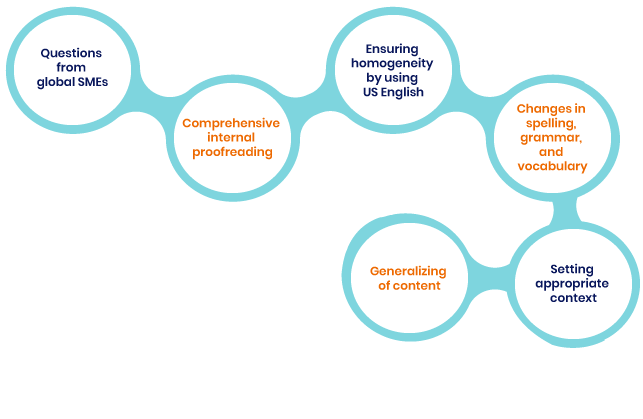When you speak to the customer in their language, you ensure a few things: familiarity, relatability, and trust. Attributes that ensure you form a connection with your audience; attributes that land sales.
And technology, as we see now, has made us privy to an audience like never before. We’re able to reach any customer segment in any corner of the world; it’s just a matter of a few clicks.
So how do we speak in a manner that establishes a linearity in our language and tone, and at the same time, reach an audience that’s global and diverse? By speaking the global business language - English, specifically US English!
In the last few decades, US English has become one of the major driving forces of the business world. All businesses, from all over the world, need a point of interaction, and that has been the US English.
This is the reason why iMocha makes a very deliberate and conscious decision to format all questions (and communications) in US English.
So, how do we do it exactly?
We have a global, internal SME group that brings in a global perspective to our questions. And while bringing in various viewpoints is important for us, it is also important to establish homogeneity in our written content.
We do so by taking one simple action: ensuring all communication follows the same one form of the English language, the US English.
We follow a detailed process, too; one that isn’t identified by its complexity, but simply by its practicality. After we get the questions from our SMEs, we run them by a group of internal proofreaders. The proofreaders, then, rewrite the question from US English standpoint to maintain the 'linearity' and 'homogeneity' of every question. Our SMEs come from all over the world, everyone would (and does) have a unique way of setting a problem. So this process helps us in maintaining the same tone throughout. For instance, there are certain skills that are required by finance and tech people alike, but wherein lies the difference is the application. So if we provide the same question for both tech and finance candidates, we’d lose them in the context setting.
And while the reach of content is vast and we wish to keep it that way, using US English helps maintain a blanket of linearity within our questions. Moreover, the context setting plays a huge role in the process, in addition to US spellings, grammar, and vocabulary.
The last part of this process is generalization. What we mean by this is making sure that readers (aka candidates) from all over the world understand. For instance, if we use the word jumper in our text, the American interpretation of this would be jumper cables, but a UK reader might interpret it as a sweater! It is to remove this ambiguity, we ensure our text is general, or easily understood by global readers. So we take situations, words, contexts that are general and leave no scope for interpretation.

What would go wrong if we don’t follow this process?
We’re in the business of assessing a candidate, we’re not in the business of alienating the candidate when they read our content. If we start using different kinds of English: US, UK, Australian, Caribbean, or even African, our readers will receive a set of questions that will test them for an additional, completely ineffectual skill, which is comprehending all forms of English. So, in order to keep the assessment process unbiased, we have to follow this blanketing process to the T.
For instance, we’re hiring two software developers, one in Europe and one in the US. While their technical skill level can be assessed using the same measure and questions, the language and comprehension cannot. Language, as we all know, is rooted in culture and society. So expecting everyone to comprehend these various kinds of English would be unfair, and might even give certain undue advantages to some people.
iMocha is a staunch believer of equal opportunity, and we’re always striving to remove all bias inducing components from the recruitment process, which is another reason why we take additional measures to ensure linearity in our content.
To read about why we give precedence to US English over any other form of English, go here.
How can iMocha help?
iMocha is the world's largest AI-powered digital skills assessment platform that helps organizations build winning teams.
Try iMocha to conduct effective pre-employment testing today! 

